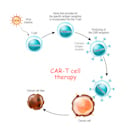
Schizophrenia: Update on Treatment Options
Mental Health Awareness Week is held each October. Besides providing awareness and education to the public, it's a reminder to healthcare professionals to review the latest in research and treatment options. As such, we're focusing this month on schizophrenia, a chronic psychiatric illness that causes devastating mental and social impairment and heavily impacts a patient's life. It is the fourth leading cause of disability in adults and has a worldwide prevalence of approximately 1%, occurring equally in both men and women. Patients are typically diagnosed with the disorder in their early 20s.
Schizophrenia symptoms may include hallucinations, delusions, mood changes, disorganized behavior and cognitive impairment. While researchers have postulated a number of risk factors for the etiology of schizophrenia (i.e. family history, environmental and developmental factors), the main theory centers around hyperdopaminergic activity in the mesolimbic pathway of the brain. This pathophysiological description of schizophrenia is based on the mechanism of action of antipsychotics which work by antagonizing post-synaptic dopamine receptors.
The diagnosis of schizophrenia includes two or more of the following: positive symptoms, disorganized speech, disorganized or catatonic behavior and negative symptoms. Positive symptoms include delusions, hallucinations, paranoia, while negative symptoms include affect flatting (lack of emotion), alogia (lack of speech), anhedonia (lack of pleasure), avolition (lack of motivation). In order to meet the diagnosis, one of the two symptoms must be delusions, hallucinations or disorganized speech. Symptoms must also be continuously present for at least six months with active symptoms for at least one month. The presentation of schizophrenia must not be due to another psychiatric, medical or substance induced cause. Delusions are defined as fixed false beliefs that are maintained despite convincing evidence otherwise and hallucinations are usually auditory and visual, rarely gustatory, tactile or olfactory. Patients diagnosed with schizophrenia will experience these symptoms throughout their life with varying degrees of severity.
The first antipsychotic, initially called a "neuroleptic," was used in 1950s. Since then, numerous other antipsychotics have been developed and prescribed in the treatment of schizophrenia. Antipsychotics are divided into two main groups: first generation or typical antipsychotics and second generation or atypical antipsychotics. Although the atypical antipsychotics are recommended as first-line treatment for schizophrenia, the typical antipsychotics have demonstrated comparable efficacy for the positive symptoms of schizophrenia and are still widely prescribed. The negative symptoms and cognitive impairment of schizophrenia are more difficult to treat and less responsive to both the typical or atypical antipsychotics. Clozapine (Clozaril) is the only antipsychotic reported to be effective in treatment-resistant patients with schizophrenia and is usually reserved for patients who have failed multiple trials with other agents.
New Schizophrenia Treatments
Four new atypical antipsychotics were developed in the past five years including paliperidone (Invega), asenapine (Saphris), iloperidone (Fanapt) and lurasidone (Latuda). These four new agents are similar in efficacy and tolerability compared to the existing atypical antipsychotics. Therefore, an antipsychotic is most often chosen based on its side effect profile.
Goals of antipsychotic treatment include reduce symptomatology, preventing or delay relapse, improve quality of life and reduce social impairment, minimizing side effects of medications and prevent suicide. Early symptoms that improve rapidly following treatment initiation include insomnia, hostility, hallucinations and poor self-care while delusions, paranoia, negative symptoms, cognitive impairment and social impairment may be slower to remit.
Because schizophrenia is a chronic disorder and patients will develop comorbid medical and psychiatric illnesses it is important to look for drug-induced disorders and drug-drug interactions. There are different formulations of many antipsychotics available including short- and long-acting injectables, oral solutions and orally disintegrating tablets. Recently, the Food and Drug Administration approved an inhaled powder formulation of loxapine (Adasuve) for treatment of agitation in bipolar and schizophrenia. Long acting injectable antipsychotics or depots may help improve adherence to antipsychotic treatment, as many patients with schizophrenia struggle with compliance to daily regimens.
For more on mental health, RN.com offers, "Caring for Patients with Mental Health Disorders," a 2-contact-hour CE course that provides nurses and other healthcare providers with guidelines for identification and care.
References
- American Psychiatric Association [APA]. (2004). Practice guideline for the treatment of patients with schizophrenia. American Journal of Psychiatry, 161 (2 suppl):1-56.
- Macaluso, M., McKnight, S. (2013). Overcoming medication nonadherence in schizophrenia: Strategies that can reduce harm. Current Psychiatry, 12:15-20.
- Schultz, S.H., North, S.W., Shields, C.G. (2007). Schizophrenia: A review. American Family Physician, 75:1821-1829.
- Treat Guidel Med Lett. (2013). Drugs for psychiatric disorders. 11:53-64.
© 2014. AMN Healthcare, Inc. All Rights Reserved.
Biography:
Andrew Muzyk is an Assistant Professor at Campbell University College of Pharmacy & Health Sciences in Buies Creek, North Carolina and practices as a Clinical Pharmacist at Duke University Hospital, where he specializes in Internal Medicine and Psychiatry. In 2012 he joined RxSchool.com, where he presents live courses and contributes to the site's CE curriculum.




